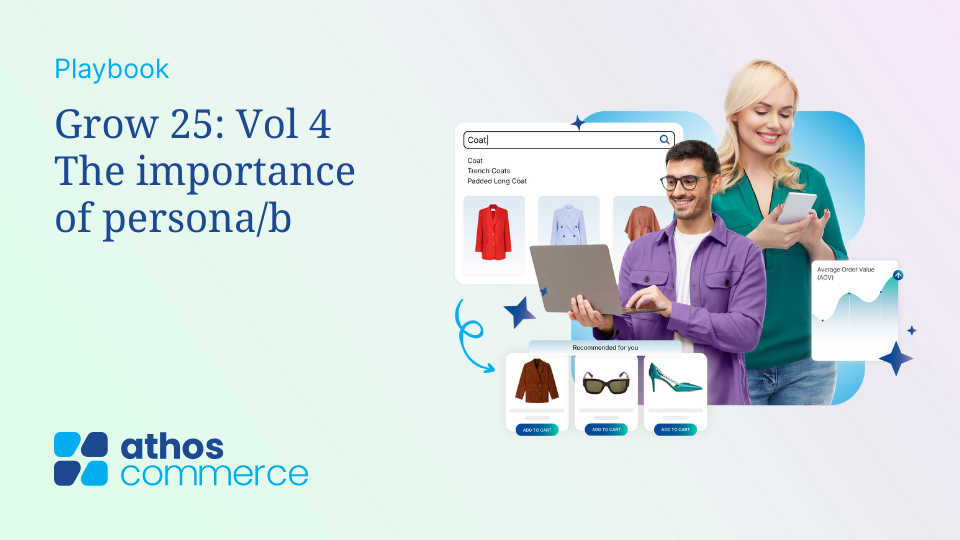Beyond search: The answer economy is here
Shoppers aren’t just browsing anymore. They’re asking questions.
Search behavior has shifted from keywords to natural language queries and from navigation to intent. Instead of searching for “headphones,” today’s shoppers ask, “Which wireless headphones are best for long flights and noise cancellation?”
This shift is reshaping the way ecommerce teams approach product discovery, and it’s fueling the rise of answer engine optimization (AEO)—the strategy of structuring your content to earn visibility in generative AI search results, voice assistants, and other AI-powered experiences beyond your website.
But off-site AEO is just one piece of the puzzle. To meet shoppers’ expectations, brands must also deliver answers on-site, particularly at critical conversion moments like the product detail page (PDP). That’s where AI-powered tools like Asklo, Athos Commerce’s conversational AI shopping assistant, come into play.
While Asklo isn’t technically AEO—it doesn’t optimize for Google or third-party AI engines—it mirrors the same principle: providing shoppers with direct, helpful answers exactly when and where they need them.
In this article, we explore how AI is transforming ecommerce search—from off-site answer engine optimization to on-site Q&A—and how you can build a strategy that aligns with what both shoppers and AI are seeking.
Answer engine optimization is only the beginning
AEO helps your brand show up when people ask questions off-site. That includes everything from Google’s featured snippets and People Also Ask boxes to results surfaced by voice assistants and generative AI search tools like ChatGPT, Google Gemini, Microsoft Copilot, Perplexity AI, and Claude.
And it matters. Juniper Research reports that 35% of traditional search queries are now conversational—phrased in natural language rather than keywords. That means your brand’s ability to surface relevant, well-structured answers is increasingly tied to discoverability.
The good news? With the right schema markup, structured content, and FAQ-rich pages, you can significantly improve your AEO performance. But the journey doesn’t end there. While answer engine optimization might bring shoppers to your site, it doesn’t help them move forward once they arrive.
That’s where an answer-led strategy truly begins.
Why on-site answers drive higher conversions
Here’s a familiar scenario: a shopper lands on your PDP, interested in a product, but they have questions. What are the dimensions of the frame? Is it available in white? What’s the return policy? Will it arrive by Friday?
If they can’t find the answers quickly, they bounce. Maybe they look elsewhere, or maybe they just give up. This is the conversion moment, and it’s where most ecommerce sites still fall short.
Product reviews, specifications, and FAQ sections are helpful, but they often require scrolling or hunting for information. That’s why tools like our conversational AI shopping assistant are changing the game. Asklo lives directly on PDPs, understands natural language, and instantly serves answers drawn from existing content, such as specs, reviews, policies, and more. By resolving shopper questions in real time, Asklo reduces friction and builds confidence—two critical drivers of conversion.
3 pillars of an answer-led ecommerce strategy
To meet the needs of today’s answer-seeking shoppers, brands must evolve beyond traditional search optimization and take a more holistic, cross-channel approach.
The three core pillars of an answer-led strategy are discoverability, decision support, and answer intelligence.
1. Discoverability: Show up in the moments that matter
To win attention off-site, your content must be answer-ready. That means:
- Implementing structured data and schema markup to support answer engine optimization
- Creating content that answers high-intent questions (e.g., buying guides, how-tos, and product comparisons)
- Optimizing for conversational and voice search by using natural, question-based language
These steps help ensure that your brand surfaces when shoppers are asking critical questions before ever landing on your site.
2. Decision support: Reduce friction on-site
Once the shopper arrives, your job is to keep them engaged and moving forward. This is where real-time Q&A becomes essential. You want to:
- Use conversational AI tools like Asklo to provide instant, product-specific answers on PDPs
- Ensure your product content is rich and complete—from materials and sizing to shipping timelines and care instructions
- Highlight policies like returns and shipping transparently
These efforts help reduce uncertainty, which is one of the biggest obstacles to conversion.
3. Answer intelligence: Turn questions into strategy
Every question a shopper asks is a signal about their intent, their concerns, or what’s missing from your product content.
With the right integration and analytics in place, you can:
- Track which questions are asked most often and improve content accordingly
- Segment audiences based on their questions (e.g., allergy-conscious shoppers, value-focused shoppers)
- Use behavioral signals to inform campaigns across email and SMS
This is especially powerful when paired with retention marketing tools like Yotpo, which now integrates directly with Athos Commerce to uncover these real-time insights for smarter personalization.
What’s next: AI’s expanding role in the answer economy
Looking ahead, the role of AI in ecommerce isn’t just about providing answers—it’s about anticipating them. We’re entering an era where agent-based shopping experiences, predictive PDP content, and dynamic Q&A will become standard.
Retailers who embrace this shift now will be better positioned to:
- Reduce bounce rates and cart abandonment
- Drive loyalty through more relevant ecommerce shopping experiences
- Capture and act on customer intent with greater precision
Answer more shopper questions. Convert more loyal customers.
Being present in search results is no longer enough. To truly compete, ecommerce brands need to evolve into answer engines themselves. That means showing up when questions are asked, delivering clarity at the moment of consideration, and using shopper signals to personalize the entire journey.
The result? An ecommerce strategy based on answer engine optimization that turns intent into action and shoppers into loyal customers.
Ready to take the next step? Download our eBook, “What AI Wants,” for a deep dive into the technologies, strategies, and tools shaping answer-driven ecommerce.



